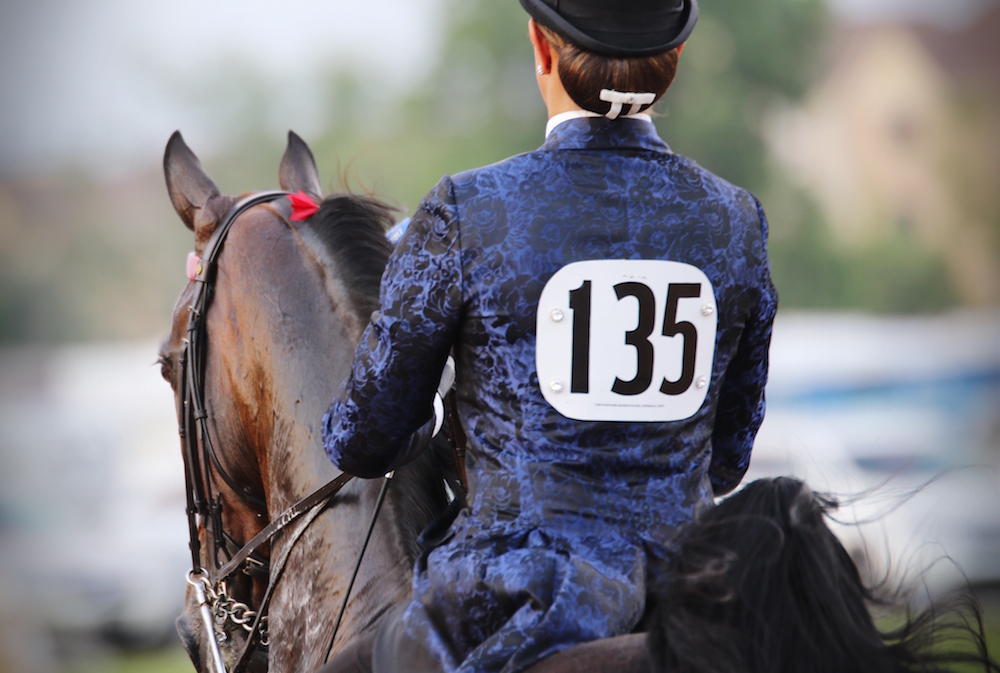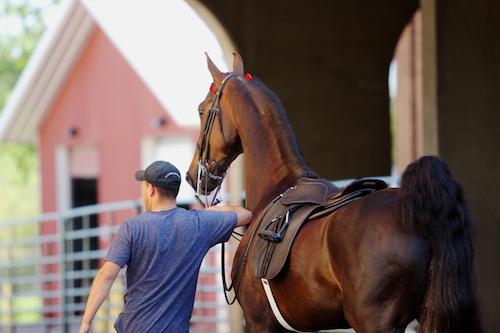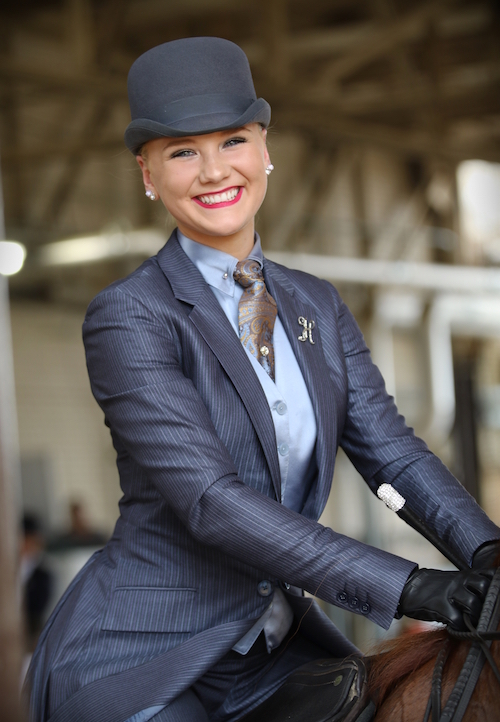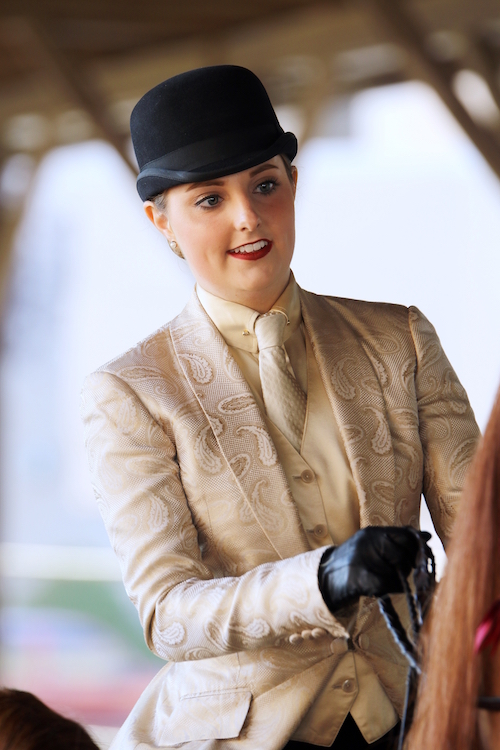 If the American Saddlebred is the “peacock” of the horse world, then the rider is its plumes. The elegant picture of a beautifully appointed horse and rider are what make saddle seat horse shows mesmerizing. When a horse and rider are well turned out for the show ring the focus is clearly on their performance, but if the rider is dressed badly or inappropriately for the class or division, this can be distracting for the judge and audience. To make sure the focus is always where it should be, there are a few common errors that exhibitors should take care to avoid.
If the American Saddlebred is the “peacock” of the horse world, then the rider is its plumes. The elegant picture of a beautifully appointed horse and rider are what make saddle seat horse shows mesmerizing. When a horse and rider are well turned out for the show ring the focus is clearly on their performance, but if the rider is dressed badly or inappropriately for the class or division, this can be distracting for the judge and audience. To make sure the focus is always where it should be, there are a few common errors that exhibitors should take care to avoid.
 One of the easiest errors to avoid is failing to follow the rules for a particular division. Luckily, the rules are written out in great detail in the United States Equestrian Federation Rule Book. When it comes to attire, each division and class has its own set of guidelines, and some rules apply across the board. For example, wearing formal attire during classes before 6 p.m. is never permissible. A top hat is to be worn only with formal wear. Avoidance of gaudy colors is referenced numerous times within the USEF guidelines, but is particularly important for equitation classes. Familiarizing yourself with the appropriate appointment guidelines for your class or division is an easy way to help avoid these errors.
One of the easiest errors to avoid is failing to follow the rules for a particular division. Luckily, the rules are written out in great detail in the United States Equestrian Federation Rule Book. When it comes to attire, each division and class has its own set of guidelines, and some rules apply across the board. For example, wearing formal attire during classes before 6 p.m. is never permissible. A top hat is to be worn only with formal wear. Avoidance of gaudy colors is referenced numerous times within the USEF guidelines, but is particularly important for equitation classes. Familiarizing yourself with the appropriate appointment guidelines for your class or division is an easy way to help avoid these errors.
Another simple show ring pitfall to avoid is a disorderly appearance. In all disciplines the USEF guidelines speak to a requirement of “neatness” in the handler or rider. Neatness starts with cleanliness. Entering a show ring with dirty or damaged tack can automatically affect the judge’s perception of the rider. Tack for the show ring should be cleaned and well conditioned. Of most importance, the saddle should be in pristine condition without dirt, dust and scuffs. Boots that are dirty and dingy can make even the most attractive suit look shabby.
Neatness also includes a properly tailored suit. Failing to use a professional equestrian tailor when ordering a new suit can lead to a riding habit that does not meet the requirements for proper show ring attire. Equestrian tailoring takes into account how a suit should look on a horse and not for general wear. A jacket that is too loose or too snug can make the rider’s form appear “off.” Pants that are ill fitting or too short take away from the seamless transition from boot to stirrup. Additionally, pants and vests that are too tight make the rider appear uncomfortable and awkward when riding.

According to popular equestrian tailor, Becky DeRegnaucourt, taking clothes to a general tailor or seamstress is likely going to lead to a poor fit.
“Fitting a business suit is very different from fitting a riding coat, pant, and vest,” Becky said. “I have had customers have their pants lengthened locally and have had them ruined.”
Some of the most widespread pitfalls in attire are problems with color combinations. Wearing a suit that is not well matched to the horse is one common mistake, as the horse and rider should look like a cohesive pair. Choosing distracting colors is another.
In recent years the trend has moved from masculine looking suits and colors for women and young riders and toward colorful expression in jackets, vests and ties. In some cases this is fine, but in others it can lead to a very distracting show ring appearance, with the chosen color and pattern not enhancing the beauty of the horse, but instead causing the rider to be the focus of attention.
“We must remember that it is a ‘horse show,’” Becky said. “Our objective is to have the rider and horse appear as a team without dividing each other. What the rider or parent may choose, is not always best for the horse or division in which they are showing. I say, flatter your horse and then finalize with what looks good on the rider secondary.”
 When determining color and pattern, involving your trainer and tailor will help to avoid choosing combinations that may lead to poor show ring appearance.
When determining color and pattern, involving your trainer and tailor will help to avoid choosing combinations that may lead to poor show ring appearance.
Mistakes can be made with accessories as well. In the eyes of a judge, the most important show ring accessory is the back number. In the show ring it is your identity. Trimming back numbers too small allows the number to blend into the suit making it hard to distinguish. While trimming numbers is acceptable, be sure to leave enough of the white background for the number to stand out. Avoid using pins or magnets to anchor only the top and bottom this creates a “butterfly effect” causing the sides to bend inward, clocking a clear view of the number as the rider passes the judge. Finally, using the metal “hanger” to attach the number to the coat collar makes it nearly impossible for a judge to see the rider number with the number flapping up and down with the rider. The solution? Invest in a set of magnets to anchor back numbers on all four corners, and be sure the number is secured between the shoulder blades and is straight. These simple fixes to a common show ring error can have a positive effect on the outcome of a ride.
Though it can be easy to forget, your headgear is part of your attire as well, and helmets, derbies, hats and top hats can also have a negative effect on how a rider looks in the ring. It is important for safety that young riders wear safety-approved helmets, especially in academy classes. However, helmets need to fit the child and should not be purchased to “grow into.” It is a good idea to invest in a helmet that has an adjustable band or dial that can be tightened or loosened as needed for proper fit. It is not only a safety risk, but a distraction in the ring if a helmet is so large that it falls below the rider’s eyebrow level or sits crooked on the head. For junior exhibitor and adult riders the derby, hat or top hat can take away from a rider’s polished appearance if it is too large or small. To avoid this, riders need to have a proper measurement by a qualified tailor to ensure the correct hat size.
A lot of detail goes into outfitting a rider for the show ring, but by avoiding these common mistakes in show ring turnout, you can put your best foot forward, and still display your own unique flair.
“If I hold them to what I would choose, or what the trainer or instructor would choose, they can end up all looking the same,” Becky said. “I think rules and guidelines can be followed along with letting them exhibit their own style in the show ring.”



